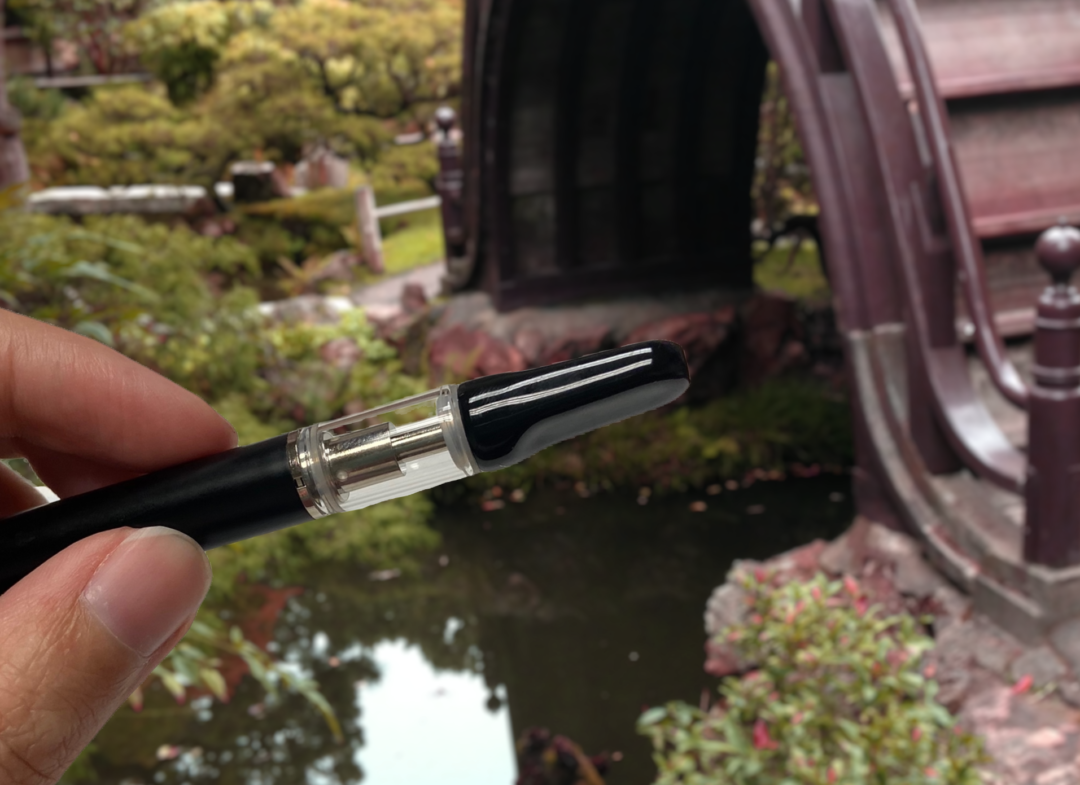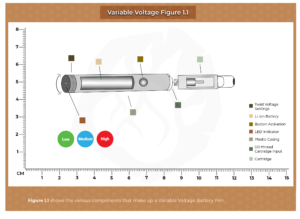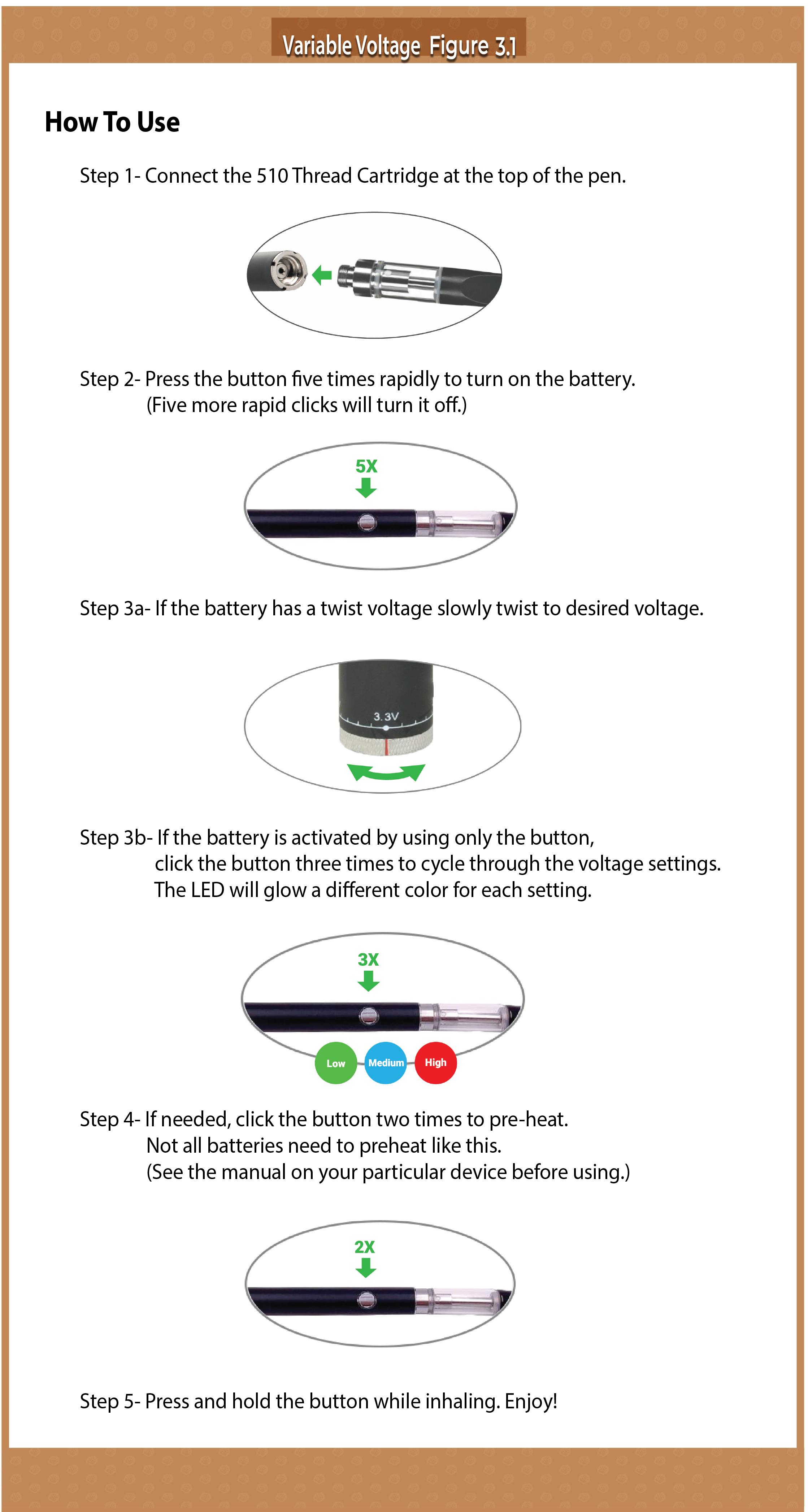Often, Vape Consumers enjoy the feeling of having control over their vape experience and are constantly seeking different methods of vaping. Variable Voltage batteries are a great option for such consumers.
Different terpenes burn off at different temperatures which means that a lower voltage can allow the subtle flavors and properties of more delicate terpenes to come forward while others need a higher voltage setting to bring out the desired effects. A lower voltage setting can also be used to create a smaller cloud effect whereas a higher voltage setting will yield a greater cloud [1].
Variable Voltage batteries like the Slim Twist, Nova, Puffstik , Pilot, and Jolt are designed to give the user more control over their vaping experience. Unlike inhale-activated batteries, Variable Voltage batteries typically come with at least three settings to help your consumers achieve the desired effect through voltage adjustments. 3.3 volts to 4.8 volts is the most common range of settings for variable voltage batteries, although it is possible to find customizable variations of voltage within the industry[1]. We will explore the ins and outs of Variable Voltage batteries (see Figure 1.1), including a step-by-step how-to guide, a detailed breakdown of the anatomy of these batteries, and finally, how they operate.
Topics
Why Carry Variable Voltage Batteries?
Most Variable Voltage batteries are button activated yet not all button activated batteries are variable in voltage. Many factors go into the decision to sell a Variable Voltage battery. Ultimately, it comes down to what the consumer is looking for and how much it costs to fulfill the market’s needs. Sometimes using the simplest of batteries such as an inhale activated battery leaves something to be desired or the consumer wishes to modulate their experience with more precision. Within the population of Vapers, there will always be people looking for something new and custom-tailored to their needs. The variable voltage batteries we carry at Bear Rootz, offer just that. With three or more temperature settings, any oil, wax, or resin is possible to vape. This is ideal if the consumer is looking to expand upon the different types of oil cartridges in their collection. The consumer will not be tied down to a particular consistency of concentrate with the use of Variable Voltage batteries.
Each concentrate is unique and has its own DNA if you will, that is made up of a blend of THC, terpenes, and other cannabinoids. Because the DNA of each extract varies, so does their heating threshold. Variable Voltage Batteries can be used to hone in on the perfect voltage to find the preferred balance of flavors and intensity that is unique to each consumer’s pallet[2]. With some practice and trial and error, the desired effects can be unlocked for the best experience.
Factors: Viscosity
The viscosity of a liquid or gas is the measure of resistance to flow or movement[3]. For instance, an oil with less viscosity is thinner and has less resistance to movement while oil with higher viscosity has a thicker consistency and takes more effort to move or evaporate. Since higher viscosity oils are thicker, higher heat is required to start the process of creating vapor. This is where Variable Voltage batteries come in handy. The consumer will have the option to buy varying consistencies of oils and concentrates when they have the power to tailor the voltages they are using. Your target audience can try out many different types of 510 threaded cartridges that pair with their newly purchased battery. This also increases the amount and type of oils, waxes, and resins you can offer within your brand.
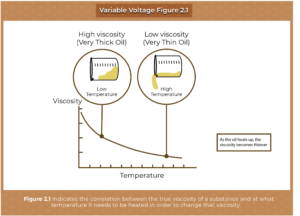
Factors: OHMs
We mentioned Viscosity and how the coil needs different voltages to overcome the thickness of a concentrate. Another factor when heating oil concentrates is called OHMs (Electrical Resistance). Ohm is the measure of resistance from the Atomizer within the vape cartridge. The higher the ohm rating of a heating coil, the less power that will pass through it. Different ohm-rated atomizers affect how hot the vapor becomes as it is delivered.
OHMs law states that: “The current through a conductor, between two points is directly proportional to the voltage across the same two points”[4]. Ohms Law can be confusing but another way to break down the notion is to think of it as plumbing. The current is the flow of water, while the voltage is the water pressure and the resistance itself would be akin to the pipe size. The pressure (voltage) can be increased or decreased, causing more water (current) to flow through the pipe. The size of the pipe (resistance) controls how much water passes through at any given time [5]. Variable voltage settings enable you to overcome the resistance factor and better regulate the overall production of vapor. Use caution when using a higher voltage as this may cause the coil to burn out quicker.
An atomizer coil with high resistance (above 1.0 ohm) is recommended to be used at a lower power setting. This potentially creates smaller clouds of vapor and uses less of the concentrate. An atomizer that has a low resistance (less than 1.0 ohm) is referred to as a sub-ohm. People tend to try sub-ohm vape cartridges when they want to utilize a greater flow of current, within the battery, which causes the vapor to be greater with less inhaling. This tends to produce bigger vape cloud plumage [6].
How to Use a Variable Voltage Battery
There are two main styles of Variable Voltage batteries. One, like the Swift Twist, has an easy twist mechanism at the bottom of the pen that controls the voltage setting. The other style is completely button operated (see the Jolt, Pilot, Puffstik, and Nova battery). All functions are done through a series of clicks or hold times on the button. Both are easy to use and great in obtaining the desired effect. Depending on the brand of variable voltage battery, the following instructions could vary. Please see the box or manual that is provided with the product for complete instructions.
Anatomy of Variable Voltage Batteries
Below in Figures 4.1 and 5.1, we cover the basic anatomy of Variable Voltage Batteries [7].
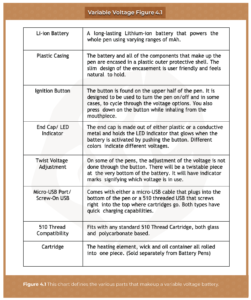
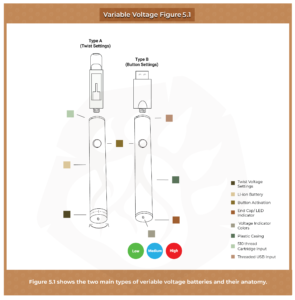
Let’s Get Technical
The technology behind how the Variable Voltage battery works is pretty straightforward (see Figure 6.1)[8].
- Pushing the button 5x turns on/off the battery.
- Once the battery is activated, either
- Twist the voltage adjuster at the bottom of the battery or
- Press the button three times to cycle through the voltage options which then tells the microchip which voltage to allow the battery to discharge.
- The battery sends the correct charge up to the circuit board that regulates the electrical output.
- Next, it sends an electrical current to the heating coil (Atomizer), within the vape cartridge, at the top of the battery.
- This causes the heating coil to get hot and vaporize the concentrate oil in the cartridge.
- This process creates a vapor that is sent into the mouth through the opening at the top of the cartridge mouthpiece.
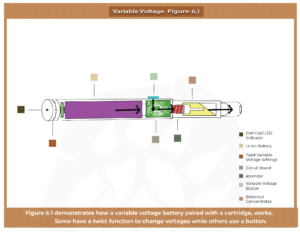
Atomizers & Coils
Atomizers and the heating coils (see Figure 7.1) of vape cartridges are important to discuss as well. Atomizers are made from different materials. Some have a base of ceramic while others are copper, brass, stainless steel, or even quartz. These factors are important because certain materials can break down or leach into the oil concentrates over time [9]. They also have different cost points. Stainless steel, for example, will hold up longer but costs more to mold while brass holds up pretty well but is more cost-effective. Ceramic heats evenly and is minimally porous. Copper, while cost-effective, tends to break down or corrode more quickly. Quartz is a new material that is starting to hit the market and is both non-porous and cost-effective.
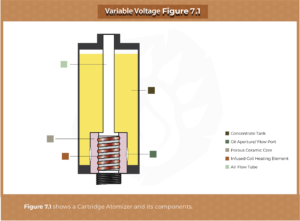
Vape Cartridges used to be made with wicking material wrapped around the metal coil but industry leaders are stepping away from this practice and using the materials mentioned above. The coil itself is wrapped in a cylinder of ceramic, brass, stainless steel, or quarts and protects the coil from direct contact with the oils to allow for a longer life span.
Different types of material last different lengths of time. Ceramic is the current go-to in the industry as it is a cleaner coil that can manage to get hotter and lasts longer than the metal coils tend to. The ceramic coils are also less likely to be broken down by fillers and sugars that are introduced into concentrates for flavor. Without needing wicking materials, ceramic and quartz coils do not have a burnt aftertaste when the oil is low, which can sometimes happen with copper, brass, and stainless steel [10].
As mentioned previously, Quartz is breaking into the industry as the newest material used for atomizer coils. Since it is not a metal but is conductive and heats evenly, there is little worry of leaching into the oils. Quartz meets all of the requirements as well as is compliant with industry standards.
Recap
To summarize, Variable Voltage batteries can help overcome resistances such as the viscosity of the concentrates, ohms within the Atomizer and give the consumer more overall control over their vaping experience. Most Variable Voltage batteries use a button for activation, but some have a twist feature (such as the Swift Twist) to change the voltage instead of using the button (such as the Nova, Puffstik S/L, Pilot, and Jolt). When it comes down to anatomy, the Variable Voltage batteries are very similar to inhale activated batteries; all the components are the same except for the added button and twist features. Variable Voltage batteries are all designed to be discreet and fun for your consumers to use.
Sources:
[1] https://openvapeshop.com/blogs/news/variable-voltage-vape-battery-guide
[2] https://pyramidpens.com/blog/2021/07/13/features-and-benefits-of-variable-voltage-vape-pen-batteries/
[3] https://www.britannica.com/science/viscosity
[4] https://en.wikipedia.org/wiki/Ohm%27s_law
[5] https://science.howstuffworks.com/environmental/energy/question501.htm
[6] https://www.vaporfi.com/sub-ohm-vaping-guide/
[7] https://www.leafly.com/news/cannabis-101/vape-pen-anatomy
[8] https://vapevetstore.com/blogs/vaporizer-learning-center/how-does-a-vape-battery-work
[9] https://ethoscannabis.com/learn/guide-to-vape-carts/
[10] https://www.greentanktech.com/news/quartz-vs-ceramic-best-coil-vape-pens/

